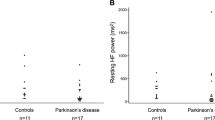Abstract
Objective The low frequency spectral component (LF; 0.04–0.15 Hz) of heart rate variability (HRV) is considered to be an index of sympathetic modulation of sinus node activity under physiological conditions, although the relationship is less clearly defined in non-physiological conditions. Several cardiovascular diseases are characterized by an absent or blunted 24-h pattern of the LF spectral component. The aim of the present study was to investigate the relationship between chronically increased neural sympathetic efferent drive to the heart, quantified in terms of downregulation of myocardial β-receptors, and the 24-h power of the LF spectral component in patients after acute myocardial infarction. Methods In 24 patients, HRV was analyzed for a 24-h period, one month after an uncomplicated Q wave myocardial infarction. The following time domain measures and spectral components were calculated: mean RR, SDNN, SDANN, RMSSD, SDNN index, pNN50, and very low frequency (VLF), low frequency (LF) and high frequency (HF) spectral components. The density of β-adrenoceptors was measured in vivo by positron emission tomography (PET) with 11C-CGP-12177. Results Post-AMI patients had normal plasma levels of adrenaline and noradrenaline (respectively 1.48 ± 0.18 and 0.28 ± 0.03 IU/L) but reduced myocardial β-adrenoceptor density (6.86 ± 0.24 pmol/g). Patients had similar heart rates but lower values of SDNN and SDANN compared with control subjects. The absolute and normalized power of the spectral components were similar in the two groups, but the usual day-night oscillation was blunted in patients. Moreover, the day-night change in the power of the LF spectral component was positively related (r = 0.51; p < 0.001) to the myocardial β-adrenoceptor density. Conclusions The loss of the day-night oscillation of the LF spectral component appears to be a significant marker of sustained sympathetic over-activity in post-AMI patients.
Similar content being viewed by others
Author information
Authors and Affiliations
Additional information
Received: 6 June 2001, Returned for revision: 26 June 2001, Revision received: 8 August 2001, Accepted: 28 August 2001
Rights and permissions
About this article
Cite this article
Guzzetti, S., Spyrou, N., Rosen, S. et al. Low frequency spectral component of heart rate variability and myocardial beta-adrenoceptor density after acute myocardial infarction. Basic Res Cardiol 97, 97–104 (2002). https://doi.org/10.1007/s395-002-8392-8
Issue Date:
DOI: https://doi.org/10.1007/s395-002-8392-8




